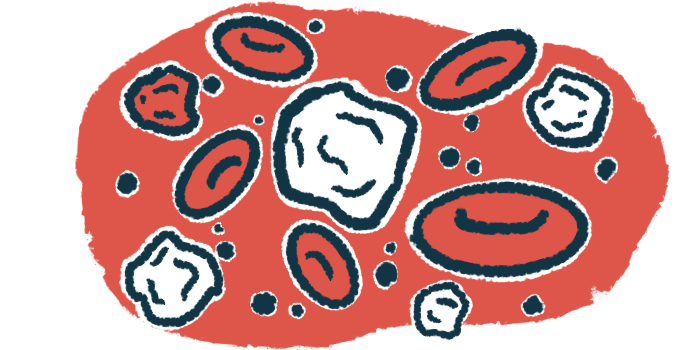Combinations of immune proteins drive different SLE symptoms
Interferon groups work together to give patients different disease presentations
Written by |

Different combinations and elevated levels of antiviral immune signaling proteins, called interferons (IFNs), were associated with differences in the symptoms and severity of systemic lupus erythematosus (SLE), a study shows.
While IFNs are known to play a role in the disease, increases in IFN levels don ‘t explain many common SLE symptoms. The findings show that both IFN-dependent and IFN-independent pathways contribute to the wide clinical variability and treatment responses in SLE, the researchers said.
“What we’ve seen in our study is that these interferon groups are not isolated; they work as a team in lupus and can give patients different presentations of the disease,” Eduardo Gómez-Bañuelos, MD, PhD, assistant professor of medicine at the Johns Hopkins University School of Medicine, Baltimore, and the study’s first author, said in a press release.
The study, “Uncoupling interferons and the interferon signature explains clinical and transcriptional subsets in SLE,” was published in Cell Reports Medicine.
SLE is an autoimmune disease marked by an immune-mediated attack against healthy tissues. Multiple organs can be affected, resulting in a wide range of symptoms that fluctuate over time. IFNs are a group of immune signaling proteins that normally “interfere” with the replication of viruses. They fall into three classes — IFN-1, IFN-2, and IFN-3 — based on their interaction with unique protein receptors on immune cells.
High IFN-1 levels are common in SLE patients and have been associated with increased disease activity, relapses, and involvement of the skin, nervous system, and kidneys.
Some SLE treatments are designed to suppress IFN-1, either via IFN-1-producing cells, the IFN-1 protein, or the IFN-1 receptor. In clinical trials, some patients failed to respond to these therapies, however, despite having high levels of IFN-1 activity.
IFNs and disease activity
Although several studies suggest that all members of IFN families, including IFN-2 and IFN-3, are elevated in SLE, the contribution of different IFNs to disease activity in SLE remains unclear.
“For years, we have accumulated knowledge that interferons play a role in lupus,” said Felipe Andrade, MD, PhD, associate professor of medicine at Johns Hopkins and one of the study’s corresponding authors. “We have seen instances where the patient surprisingly didn’t improve — we wondered if certain interferon groups were involved.”
The researchers measured IFN-1, IFN-2, and IFN-3 activity levels in the bloodstream of 191 SLE patients and 56 healthy people using human cell lines modified to respond to each specific interferon group.
Compared with healthy controls, all three IFNs were elevated in the blood of SLE patients, with IFN-2 being the most prominent (66%), followed by IFN-3 (55%) and IFN-1 (32%). Most patients fell into one of four categories: high IFN-1 levels; high levels of IFN-2 and IFN-3; high levels of all three IFNs; and normal IFN levels.
Using samples collected from patients over time, the investigators found that, like disease activity, the IFN levels fluctuated during the course of SLE.
They also found that specific IFNs were associated with certain symptoms and features. Elevated IFN-1 levels were mainly associated with skin involvement, such as rashes. IFN-2 was associated with a longer disease duration, while IFN-1 and IFN-3 were significantly associated with scores on the SLE disease activity index (SLEDAI), a measure of disease severity.
Features of systemic disease, including arthritis, self-reactive antibodies against DNA, and damage to organ systems, such as the kidneys, were only linked to the elevation of all three IFN types, “suggesting an additive effect of the three IFN families in severe SLE,” the researchers wrote.
Still, some symptoms and clinical features, such as low platelet counts, mucosal ulcers, and blood vessel inflammation, were unrelated to high IFN levels.
Commonly used immunosuppressants had distinct effects on IFNs, with IFN-1, either alone or with IFN-2 and IFN-3, being the main one affected by treatment.
SLE patients display unique gene activity profiles, including an IFN signature, a specific set of genes whose activity is influenced by IFNs. Experiments showed IFN-2 was linked to IFN-1-independent gene activity profiles, while IFN-3 enhanced IFN-induced gene activity when co-elevated along with IFN-1.
The gene activity profiles associated with increased activity of all three IFNs overlapped with pathways enriched in the IFN-1, IFN-2, and IFN-2 plus IFN-3 subsets, which was “consistent with immune activation by the combined effect of the three IFN families,” the researchers wrote.
Impaired regulation of IFNs didn’t explain the IFN signature in more than half (64%) the patients or disease manifestations of low blood cell counts and inflammation of the tissues lining the lungs, heart, and abdomen, “implying IFN-independent [subtypes] in SLE,” they wrote. “Our findings underscore that both IFN-dependent and IFN-independent pathways contribute to clinical heterogeneity in SLE and that anti-[IFN-1] therapies are more likely to be beneficial in patients with high levels of bioactive [IFN-1] rather than a high IFN signature.”






